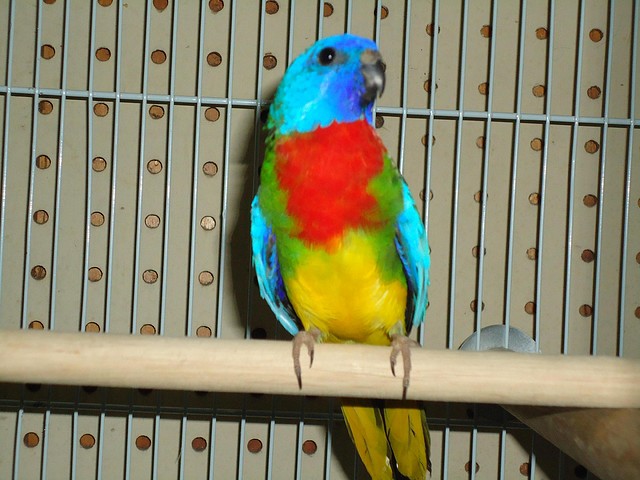
Scarlet-chestedparrot, or Scarlet-breasted parrot, or Orange-throated parrot, or Splendid parrot (Neophema sptendida)
Phylum —chordata
Class — aves
Order — psittaciformes
Family — psittaculidae
Genus – neophema
Appearance
Measuring 19–21 cm (8 in) in length, this small vibrant and brightly colored parrot is sexually dimorphic. The male has a scarlet chest, a cobalt blue face, and bright green upperparts. The lower breast and underparts are yellow, and the wing coverts are pale blue. The tail is green, the eyes are brown and the bill is blackish, and legs are brown-grey. The female likewise has a blue face, although the coloration is less extensive, green upperparts and green breast, with yellow underparts. Immature birds are duller versions of their respective adult forms.
Habitat
The Scarlet-chested parrot is sparsely scattered across the dryer southern parts of the Australian continent, from Pingelly, Corrigin and Laverton in Western Australia east across South Australia and into the southern Northern Territory and into far western New South Wales.
Diet
Seeds of grasses make up the diet, and they are thought to utilise succulent plants such as Calandrinia to meet much of their fluid requirement.
Reproduction
Breeding season is from August to October or after rainfall, with one or occasionally two broods raised depending on rainfall. A hollow in a small tree, often a mulga or eucalypt, is utilised for nesting, and a clutch of four to six round white eggs measuring 23×19 mm is laid there.
In captivity
With enough patience and good care, these parrots can live without any issues, for 15 or more years.
Relatively quiet and small as far as parrots go, these birds can be an ideal pet if you live in an apartment or condominium. The cage should be about 4 feet long by 2 feet wide and 2 feet deep. The bars should be no more than 1/2-inch apart. They can get along with most other peaceful small birds like finches and budgies and can be housed in the same cage or aviary if there is enough space for all the birds.
Scarlet-chested parrots prefer warm, dry climate. They are uncomfortable in humid and damp conditions and cannot handle extreme temperatures.
These birds prefer taking a bath in standing water or on wet foliage. Keep a small clean bowl of bathing water inside the cage. They also like to sunbathe by puffing out their feathers and bending their wings.
Scarlet-chested parrots spend a lot of time on the ground foraging for food in the wild. To emulate this behavior in captivity, provide plenty of foot toys. The toys keep the bird engaged and active. You can also put some soil and grass at the bottom of the cage to let it scratch around. Hang small, wooden branches, perches, and swings in the cage to keep them busy throughout the day. Provide a secure, bird-proof area where they can play in a safe area outside of their cages, supervised, for 3 to 4 hours per day.
For your Scarlet-chested parrot, your first choice should be a commercial seed mix that is designed for small birds or parakeets specifically. Similar mixes for budgies, turquoise parrots or even lovebirds, could work as well. This diet should be enriched with a variety of small nuts, fresh fruits, and vegetables. Another recommendation is a cuttlebone. It offers a variety of proteins, and more importantly- calcium.
 Russian
Russian
 English
English


















